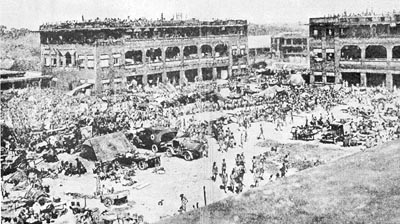

(Above) The Selarang Barracks during September 1942, where more than 15,000 PoWs were imprisoned within by the Japanese authority.
The Selarang Barracks was originally part of the huge British military base situated at Changi. Built in 1937, the Selarang Barrack was the site which the September 1942 'Selarang Incident' took place.
After the surrender of the Allied forces in Singapore on 15 February 1942, the PoWs were concentrated in four of the barracks in changi and placed under the temporary administration of General Percival. After most of the British officers were transferred to Formosa (now known as Taiwan), the Japanese set forth to establish a proper PoW camp regime. No sooner had they taken over, four escapees from a camp at Bukit Timah were caught. Firmly believing that a PoW has no right to escape, the prisoners were asked to sign a "no escape" pledge. When the prisoners refused, all the British and Australian prisoners in Changi (approximately 17,000) were concentrated in the Selarang Barracks. Following deteriorating living conditions after three days in the barracks and fearing the outbreak of an epidemic, the Allied senoir officers ordered the men to sign the pledge. The prisoners were returned to their original barracks after doing so, thus ending the episode.

(Above) The decommissioning ceremony of 42 SAR in December 1983 at the Selarang Barracks' parade sqaure.
The barrack was retaken by the British after end of the war and used until their departure in 1971. Making full use of the inherited asset, 42 SAB was subsequently raised at the Selarang Barracks under the command of MAJ Thomas Teo, when two companies were transferred from 41 SAB on 1 October 1971. The unit was to remained there until their temporary decommissioning in December 1983.
[ Back ]